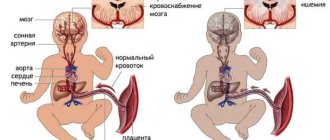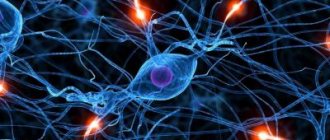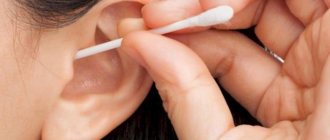Intracranial pressure in infants increases due to natural causes. In some cases, this is a signal for the formation of a serious illness.
The pressure exerted on the brain in the skull is generated by spinal fluid. It fills the cerebrospinal fluid pathways in the brain between the membranes, and also passes into the subarachnoid space.
A significant change from the generally accepted norm leads to serious consequences. Long-term high blood pressure often indicates deviations from the norm and the development of possible diseases. This symptom is rare in children.
As a rule, it is always associated with serious illnesses, which in certain cases lead to disability. In infants, the normal intracranial pressure ranges from 1.5 to 6 mmHg. If during the measurement process this indicator is exceeded, this indicates some violations occurring in the child’s body.
Causes of increased ICP
This disease in infants is most often congenital, in some cases acquired.
The most common causes of ICP include:
- birth injuries, long labor process;
- placental abruption, its rapid aging;
- taking illegal drugs by a pregnant woman;
- prolonged toxicosis in women (can last until childbirth);
- entanglement of the child in the umbilical cord, poor flow of oxygen to the fetus.
Head injuries that are caused by hemorrhage can also cause increased pressure inside the skull.
In some cases, ICP is a symptom of the development of serious, serious diseases: metabolic disorders, brain tumors, as well as meningitis, encephalitis, hydrocephalus.
Signs of such a disease also appear in cases where the baby’s parents or relatives already had problems with ICP. Increased fatigue, as well as nervous excitability, are the main causes of disorders in the baby’s body.
Symptoms of intracranial pressure in children
Signs of intracranial pressure in a child vary depending on age and the nature of the pathology. Several age groups are distinguished to differentiate the clinical picture - children from 2 to 5 years old are classified as the younger group, and from 5 to 9 years old - to the older group. Due to the ossification of the skull structures, intracranial pressure responds well to conservative treatment in older children (10 and 11 years old) - which is why it is not critically dangerous for them.
Intracranial pressure can fluctuate under the influence of atmospheric pressure, so a slight increase does not necessarily indicate any pathology.
Symptoms common in young children include:
- Restlessness in the evening and at night, sleep disturbances, severe crying. The reason is an increase in intracranial pressure due to the horizontal position of the body. In this case, the venous system of the skull receives more blood, so the sinuses swell and the pressure increases.
- Nausea and vomiting. Associated with pressure on the structures of the medulla oblongata, which are responsible for the gag reflex. It is necessary to distinguish this symptom from vomiting associated with overfeeding a child or food poisoning. Vomiting of central origin is not associated with food intake, occurs several times a day, and the nature of the vomit does not change.
- Increase in head size. This is possible in a baby under 1 year of age, since in older children the fontanelles ossify. In young children, the cartilaginous structures in the skull dominate, so the fontanelles swell, the sutures of the skull separate, and the frontal lobe enlarges significantly. Visually this is manifested by an enlargement of the head.
- Prominent subcutaneous venous network. If a child has high cranial pressure, the veins are full-blooded and contrast under the skin in the form of a clearly visible vascular network.
- Graefe's symptom. This sign is specific to birth trauma, but sometimes manifests itself when pressure in the cerebrospinal fluid system increases. It is characterized by spontaneous downward movements of the eyes, with a white stripe of sclera visible between the upper edge of the iris and the upper eyelid.
Nonspecific symptoms associated with increased intracranial pressure indirectly include frequent crying, refusal to feed, developmental delays, lethargy and lethargy.
Children are especially sensitive to changes in intracranial pressure due to the special vulnerability of the nervous system due to age, as well as the presence of cartilaginous structures in the skull.
Older children may complain of subjective sensations caused by high blood pressure. In this case, diagnosing the pathological condition is somewhat easier. Main features:
- Vomiting that does not bring relief. Occurs due to irritation of the vomiting centers. Repeated many times, the child complains of nausea, which does not go away after a bout of vomiting.
- Headache. Pain is felt behind the eyeballs (cerebrospinal fluid presses on the space behind them), as well as in the area of the frontal and temporal lobes.
- Symptoms of irritation of the optic nerves. The child complains of flashes before the eyes, colored trails that trail behind objects, and double vision.
- Sleep disorders. Caused by increased compression of the brain and pain when lying down.
High intracranial pressure deprives the child of appetite, making him lethargic and moody throughout the day.
A further increase in intracranial pressure can lead to the development of dangerous consequences. On the part of the nervous system, this is a delay in mental development (especially dangerous during the active formation and development of the brain - at 3-4 years), retardation in physical development, visual impairment and other neurological disorders.
Symptoms and signs
As a rule, intracranial pressure increases gradually in a child, which is why parents do not always detect disorders in time.
There are certain signs of intracranial increased pressure in infants. This list should include:
- divergence of the skull bones;
- slow child development;
- visual impairment, strabismus;
- a fontanelle that protrudes outward;
- the appearance of subcutaneous venous plexuses;
- an increase in the volume of the head, its rapid growth, disproportion.
However, elevated ICP cannot be detected by the appearance or size of the head. To make an accurate diagnosis, specialists use modern equipment.
As for the symptoms of the disease, increased ICP may be indicated by:
- restless sleep, lethargy of the baby, drowsiness;
- irritability and excessive tearfulness of the child;
- nausea, frequent regurgitation, shuddering, and protruding eyes;
- lack of weight gain, head tilt, nosebleeds.
The baby cannot yet tell his parents about his health. Therefore, adults only have to guess about various disorders in the baby’s health.
None of the above signs is a reason to establish a diagnosis of “increased ICP.” The guesses of parents and doctors are supported by the results of special studies.
ethnoscience
To reduce intracranial pressure in a child, along with medications and physiotherapeutic procedures, you can try using various medicinal preparations.
For example, you can prepare a decoction of lavender. To do this, you need to pour one spoon of dried flowers with a glass of boiling water. After this, boil the mixture for 3 minutes and leave for half an hour. It is recommended to drink the resulting remedy for a month, after which you need to take a two-week break and repeat the treatment again. Additionally, a decoction of lavender can be gently rubbed into your baby's scalp before he goes to bed.
Another useful remedy is mulberry. You can also prepare a medicinal decoction from it to lower ICP and relieve headaches. To do this, place a small bunch of herbs in a liter of clean distilled water and boil for 15 minutes. After this, the broth must be filtered and divided into several equal parts. However, it is worth considering that this medicine can only be drunk fresh, so it will have to be prepared daily.
How to determine?
The simplest diagnostic methods include examination by an ophthalmologist or neurologist. In this case, specialists must check the fundus of the eye and measure head parameters.
Norms are determined in accordance with the age of the child. If the baby is observed by a specialist for a long time, the doctor regularly analyzes changes in important parameters.
Experts determine ICP in infants using the following methods:
- MRI or computed tomography is prescribed: one of the most accurate research methods. Has minimal errors in the results obtained;
- a puncture is taken: the meaning of this study is to insert a needle into the ventricles of the brain. It can also be inserted into the spinal canal. The data obtained allows specialists to find out the value of the infant’s intracranial pressure;
- perform an ultrasound of the brain: one of the most informative methods. Such a study is not carried out in the first three days after birth. The purpose of an ultrasound is to study the tone and assess the degree of filling of blood vessels with blood. The accuracy of this method depends on the quality of sensor fixation and the emotional state of the baby.
Diagnostics
If ICP is suspected, the following diagnostic methods are used:
- Neurosonography - ultrasound of the brain (measures echogenicity, intracranial space).
- Doppler examination (checks the condition of blood vessels).
- Computed tomography (the brain is examined from different sides, the pathological condition of the ventricles is revealed).
- Magnetic resonance imaging (pathological changes in the tissue structures of the brain are detected, and places of cerebrospinal fluid accumulation are indicated).
- Lumbar puncture (a sample of cerebrospinal fluid is taken for close examination).
- X-ray examination of the skull (defects of the cranial bones are determined).
- Ophthalmological examination of the fundus (eye pressure is measured)
How to measure the state of cerebrospinal fluid in babies?
Instrumental diagnostic methods reveal the overall picture of disorders. To make an accurate diagnosis, you need to measure intracranial pressure. For this purpose, a puncture of the ventricles and cerebrospinal fluid is taken. This procedure is carried out with the written consent of the parents in their presence and only in cases where diagnosing ICP based on its symptoms is not enough. When a puncture is taken, an additional examination of the functioning of internal organs is carried out.
Interesting: Headaches in a 4-year-old child: causes, prevention, emergency care
If a problem with intracranial pressure is identified, the child is taken under observation by a neurologist.
Possible complications
If the causes of ICP disorders were not identified in a timely manner, the child may experience the following consequences:
- hydrocephalus;
- mental retardation;
- emotional and mental disorders;
- severe headaches that are difficult to get rid of.
The prognosis for the treatment of increased RR in infants is optimistic.
If the normal level of cerebrospinal fluid is significantly exceeded, the doctor in most cases prescribes surgery. It is not recommended to refuse it, because after rehabilitation, children begin to feel much better: headaches go away, problems with appetite are eliminated.
If the operation is carried out under the supervision of an experienced specialist, the final result will be excellent.
Consequences
Choosing the right path to combat intracranial pressure is not so easy. While doctors decide how to properly treat the disease, the child suffers greatly. The baby has a headache, he often wakes up at night, is often tired, is too excited during the day, and finally does not develop well mentally and physically.
- We recommend reading: norms of blood pressure and pulse in a child
Intracranial pressure, especially if left untreated, has very bad consequences. The child develops vegetative-vascular dystonia, which clearly manifests itself at the stage of puberty in adolescents.
It is during adolescence that it becomes obvious that untreated hypertension, together with hormonal changes, is fraught with improper functioning of the hypothalamus. The hypothalamus is the part of the brain responsible for satiety and thermoregulation. As an adult, a person often complains of headaches, dependence on the weather, poor memory, attention, weakness and fatigue.
You can often hear from parents that their child has increased intracranial pressure. The variety of symptoms that can be explained by the dysfunction of the nervous system leads to the fact that the appearance of at least one such alarming sign forces one to refer to this phenomenon. In fact, increased intracranial pressure in a child can be caused by very serious reasons, or it can be benign and not pose any danger. This article will help you understand this issue.
Treatment
Treatment of elevated ICP involves identifying the underlying causes of this condition.
Therapy with surgical intervention is the most difficult method. They resort to it when there is no other alternative. In some cases, a situation with the installation of a special shunt is indicated.
Thanks to it, excess fluid is removed from the brain. The doctor places the shunt in most cases for several weeks. In more complex situations, the patient can wear it for several years.
In addition to surgical intervention, the following techniques are used in practice:
- massage course;
- physiotherapy;
- homeopathic medicines;
- sedatives (prescribed only by a doctor);
- vitamin complexes that improve cerebral circulation.
Self-medication in this case is very dangerous. The most suitable treatment program is drawn up by the doctor in the process of research, which is obtained empirically. The condition of infants with increased RR is favorably influenced by prolonged breastfeeding.
As for folk remedies, this problem cannot be solved with their help. However, headaches can be slightly reduced using these methods.
To reduce the symptoms of ICP, the following universal formulations are actively used:
- decoction of mulberry branches;
- inhalation on bay leaves;
- birch sap, which does not contain preservatives;
- lavender oil (warm to room temperature and gently lubricate whiskey).
It is not recommended to replace medications with natural folk remedies. It is advisable to use them together after talking with a doctor.
Any alcohol tinctures are strictly contraindicated for infants. However, you can do inhalations, as well as use decoctions, after discussing them with your doctor.
If the baby’s parents notice any symptoms in time, and they do everything that the doctor advises, the consequences of this disease can be quickly eliminated. You can use traditional medicine to your advantage only after consultation with your doctor.
Prevention
To prevent increased ICP in infants, regular walks in the air are recommended.
Thanks to this, it will be possible to normalize the child’s emotional state. A sufficient amount of oxygen has a beneficial effect on the condition of the cerebrospinal fluid. In addition, it is recommended to ensure that the baby’s body receives a complete set of vitamins.
This is especially difficult with artificial feeding. Parents should also remember that babies are especially sensitive to any loud noises, so the atmosphere around the baby should be calm.
Video on the topic
About the symptoms and dangers of ICP in children in the video:
When you detect increased ICP in young children, there is no need to panic. This disorder can be eliminated if the correct treatment is prescribed. However, parents should not try to cope with this problem on their own. It is very important to pay attention to clinical symptoms, as well as changes in the baby’s mood and behavior.
As a rule, this problem is discovered at home. After this, it is necessary to undergo diagnostic procedures in a medical institution as soon as possible. If the doctor suggests hospitalization, you should not refuse it. After all, home treatment is less effective.
The information on the MyMedNews.ru website is for reference and general information, collected from publicly available sources and cannot serve as a basis for making a decision on the use of medications in the course of treatment.
MyMedNews.ru
And we also have
Researchers have named the number of people with synesthetic vision











